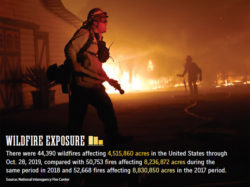Managing the risk of wildfire seems to be as hard as managing the wildfire itself in the new normal of “public safety power shut-offs” and extreme weather conditions in California.
Parts of the state are facing “extremely critical” fire weather conditions, according to the National Oceanic and Atmospheric Administration’s Storm Prediction Center, as the combination of strong winds and low humidity creates repeated warnings and ongoing danger for communities in both Northern and Southern California.
California Gov. Gavin Newsom declared a statewide emergency Oct. 25 due to the effects of unprecedented high-wind events that resulted in fires and evacuations across the state.
Meanwhile, Pacific Gas & Electric Co. has turned off the power multiple times as a “precautionary measure” to reduce wildfire risk across portions of the state, leaving several million homes and businesses without electricity.
Even customers not experiencing extreme weather conditions in their locations may be affected by a power shut-off, San Francisco-based PG&E said, because the electrical system relies on power lines working together to provide electricity across cities, counties and regions.
PG&E also warned that it may take several days to fully restore power after the weather passes and safety inspections are completed.
This means that amid the dynamic conditions that fuel wildfires, business owners and residents could face several rounds of power shutoffs, and some may not even get electricity restored between events. Add to that mandatory evacuations, hospitals, schools and businesses closed in fire areas, major roadways blocked to traffic, displaced workers, emergency management and fire responders working at full tilt, and smoke impacts in areas beyond the fires, and you have a situation that presents cascading challenges to risk managers across many different public- and private-sector entities.
In the ongoing debate on how to mitigate the financial effect, much focus has been placed on the cause of wildfires, given the record $25 billion in insured losses resulting from the 2017 and 2018 wildfires.
PG&E said in September it had reached an $11 billion settlement with entities representing about 85% of insurance subrogation claims relating to those wildfires.
While the connection between power lines and wildfires can’t be ignored, the human factor is responsible for most ignitions, according to risk modelers and insurers.
Then there’s the climate factor. The weather, climate and environmental conditions that make a certain property or area wildfire-exposed change from season to season and year to year, Swiss Re Ltd. said in a recent report.
Just as wildfires remain dynamic, not static, events, one approach to managing wildfire risk likely won’t work. It will take a range of viewpoints from across an organization or organizations to manage this complex and changing risk moving forward.
For example, if insurance isn’t affordable or available, establishing risk pools may be a way for businesses to share the financial risks. Having a risk management framework that incorporates values around land resources and management and assesses the operational impact of different approaches is another consideration.



